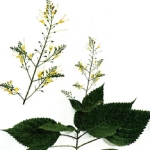| Common Name: |
Horse Balm |
| Other Names: |
Archangel, Canadian Horsemint, Hardhack, Horse Weed, Knob Root, Richweed, Rock-Weed, Stone Root |
| Botanical Name: |
Collinsonia canadensis |
| Genus: |
Collinsonia |
| Family: |
Lamiaceae |
| Native Location: |
E. USA |
| Cultivation: |
Moist soil in partial shade. |
| Propagation: |
By seed sown in spring or autumn. |
| Harvest: |
Roots are lifted in autumn and used fresh or dried for decoctions, liquid extracts, and tinctures. Roots need long extraction and are better fresh or made into a syrup. Leaves are picked as required and used fresh. |
| Height: |
60cm-1.2m (2-4ft) |
| Width: |
45-90cm (18-36in) |
| Hardiness: |
Z3-9 |
| Parts Used: |
Roots, leaves, Rhizome |
| Properties: |
A bitter, astringent, unpleasant-tasting herb that has diuretic and anti-inflammatory effects, and acts as a tonic for the capillaries and digestive system. |
| Medicinal Uses: |
Internally for kidney and urinary stones, cystitis, diarrhea, gastroenteritis, irritable bowel syndrome, mucous colitis, hemorrhoids, and varicose veins (roots). Combines well with Aphanes arvensis (See, parsley piert), Eupatorium purpureum (See, Joe-Pye weed), and Hydrangea arborescens (See, wild hydrangea). Externally for healing bruised or sore skin (leaf poultice).
To treat gastrointestinal disorders, bladder inflammation, and kidney stones. |
| Typical Dose: |
A typical dose of stone root may range from 1 to 4 ml of liquid extract (1:1) |
| Possible Side Effects: |
Stone root's side effects include gastrointestinal irritation, nausea, dizziness, and painful urination. |
| Drug Interactions: |
| Taking stone root with these drugs may increase the diuretic effects of the drug: |
| Acetazolamide, (Apo-Acetazolamide, Diamox Sequels) |
Amiloride, (Midamor) |
Azosemide, (Diat) |
Bumetanide, (Bumex, Burinex/center> |
| Chlorothiazide, (Diuril) |
Chlorthalidone, (Apo-Chlorthalidone, Thalitone) |
Ethacrynic Acid, (Edecrin) |
Etozolin, (Elkapin) |
| Furosemide, (Apo-Furosemide, Lasix) |
Hydrochlorothiazide, (Apo-Hydro, Microzide) |
Hydrochlorothiazide and Triamterene, (Dyazide, Maxzide) |
Hydroflumethiazide, (Diucardin, Saluron) |
| Indapamide, (Lozol, Nu-Indapamide) |
Mannitol, (Osmitrol, Resectisol) |
Mefruside, (Baycaron) |
Methazolamide, (Apo-Methazolamide, Neptazane) |
| Methyclothiazide, (Aquatensen, Enduron) |
Metolazone, (Mykrox, Zaroxolyn) |
Olmesartan and Hydrochlorothiazide, (Benicar HCT) |
Polythiazide, (Renese) |
| Spironolactone, (Aldactone, Spiroton) |
Torsemide, (Demadex) |
Triamterene, (Dyrenium) |
Trichlormethiazide, (Metatensin, Naqua) |
| Urea, (Amino-Cerv, UltraMide) |
Xipamide, (Diurexan, Lumitens) |
|
| Supplement Interactions: |
May enhance the effects of herbs and supplements that have diuretic properties, such as Agrimony, Celery, Shepherd's Purse, and Yarrow. |
| Bibliography: |
Encyclopedia of herbs by Deni Brown Copyright © 1995, 2001 Dorling Kindersley Limited. pg 176-177
The Essential Herb-Drug-Vitamin Interaction Guide by Geo. T. Grossberg,MD and Barry Fox,PhD Copyright©2007 Barry Fox,PhD Pp. 442-443 |

